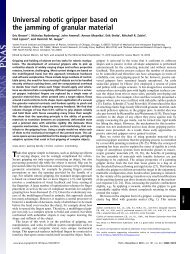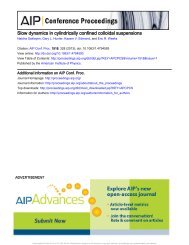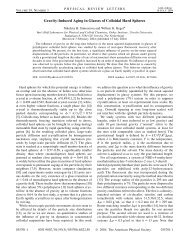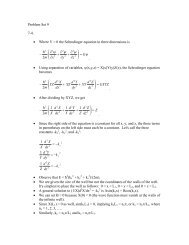Distribution of Glass Transition Temperatures in Free-Standing ...
Distribution of Glass Transition Temperatures in Free-Standing ...
Distribution of Glass Transition Temperatures in Free-Standing ...
Create successful ePaper yourself
Turn your PDF publications into a flip-book with our unique Google optimized e-Paper software.
Macromolecules<br />
Figure 5 shows details <strong>of</strong> how the underlayer thickness <strong>of</strong> freestand<strong>in</strong>g<br />
bilayer PS films affects the T g <strong>of</strong> a 14 nm thick freesurface<br />
layer and compares these results to those for supported<br />
PS films from Ellison and Torkelson. 10 When the total thickness<br />
<strong>of</strong> a PS free-stand<strong>in</strong>g film is ∼56 nm or greater, the 14 nm thick<br />
surface layer exhibits a T g that is ∼34 K below bulk T g . With<strong>in</strong><br />
experimental error, this result is <strong>in</strong> agreement with the results for<br />
substrate-supported PS films show<strong>in</strong>g that the T g <strong>of</strong> a 14 nm thick<br />
free-surface layer is ∼32 K below bulk T g when the total film<br />
thickness exceeds ∼60 nm. However, when the total freestand<strong>in</strong>g<br />
PS film thickness decreases below ∼56 nm, the<br />
14 nm thick surface layer exhibits a T g that decreases below<br />
T g,bulk 34 K with decreas<strong>in</strong>g total film thickness and is with<strong>in</strong><br />
error identical to that <strong>of</strong> the average T g across the whole film; i.e.,<br />
the film exhibits no significant T g gradient as reported by 14 nm<br />
thick labeled layers. In particular, a 43 nm thick s<strong>in</strong>gle-layer freestand<strong>in</strong>g<br />
PS film exhibits T g = T g,bulk ∼54 K, which is with<strong>in</strong><br />
error ((2 3 K) identical to T g = T g,bulk ∼57 K exhibited by a<br />
14 nm thick free-surface layer <strong>in</strong> a 43 nm thick bilayer freestand<strong>in</strong>g<br />
PS film. This behavior is the opposite <strong>of</strong> that observed <strong>in</strong><br />
substrate-supported films with thicknesses <strong>in</strong> the range<br />
∼25 60 nm but similar to that observed <strong>in</strong> substrate-supported<br />
films with thicknesses less than ∼25 nm.<br />
The results <strong>of</strong> the free-stand<strong>in</strong>g PS films reported here and the<br />
results <strong>of</strong> the substrate-supported PS films reported by Ellison<br />
and Torkelson 10 are <strong>in</strong> substantial agreement with and complement<br />
each other. When total film thickness is ∼56 60 nm or<br />
greater, a 14 nm thick free-surface layer exhibits a T g value that is<br />
∼32 34 K below T g,bulk , regardless <strong>of</strong> whether the film is freestand<strong>in</strong>g<br />
or substrate-supported. This may be understood from<br />
the standpo<strong>in</strong>t that the local T g behavior at the opposite <strong>in</strong>terface<br />
(polymer air <strong>in</strong> the case <strong>of</strong> a free-stand<strong>in</strong>g film and polymer<br />
substrate <strong>in</strong> the case <strong>of</strong> a supported film) cannot propagate<br />
across a PS film <strong>of</strong> 56 60 nm thickness and thereby perturb the<br />
T g response <strong>of</strong> the labeled free-surface layer.<br />
With decreas<strong>in</strong>g thickness below ∼56 60 nm, a 14 nm thick<br />
free-surface layer exhibits a T g that is strongly perturbed by the<br />
nanoscale conf<strong>in</strong>ement <strong>of</strong> the whole film, with the surface-layer<br />
T g be<strong>in</strong>g impacted by the presence <strong>of</strong> the <strong>in</strong>terface (polymer air<br />
or polymer substrate) on the opposite side <strong>of</strong> the film. In the<br />
case <strong>of</strong> free-stand<strong>in</strong>g PS films, the presence <strong>of</strong> a second freesurface<br />
only several tens <strong>of</strong> nanometers away from the labeled<br />
free-surface layer perturbs the T g response <strong>of</strong> the labeled layer,<br />
result<strong>in</strong>g <strong>in</strong> net reduction <strong>in</strong> the observed T g <strong>in</strong> the free-surface<br />
layer and averaged across the film as a whole. In contrast, with<br />
substrate-supported PS films <strong>in</strong> the thickness range ∼25 60 nm,<br />
the propagation across the whole thickness <strong>of</strong> the T g behaviors<br />
present at both <strong>in</strong>terfaces not only <strong>in</strong>hibits a reduction <strong>of</strong> the freesurface<br />
layer T g but also results <strong>in</strong> an <strong>in</strong>crease <strong>in</strong> the free-surface<br />
layer T g with decreas<strong>in</strong>g thickness. With sufficiently th<strong>in</strong> supported<br />
PS films (less than ∼25 nm thick), the films are unable to<br />
support a significant gradient <strong>in</strong> T g dynamics across the film,<br />
lead<strong>in</strong>g to an apparent suppression <strong>of</strong> the T g gradient. This<br />
∼25 nm thickness is roughly one-half the thickness at which the<br />
apparent full suppression <strong>of</strong> the T g gradient is observed <strong>in</strong> freestand<strong>in</strong>g<br />
PS films, which is caused by the effects <strong>of</strong> two free<br />
surfaces propagat<strong>in</strong>g <strong>in</strong>to and across the free-stand<strong>in</strong>g films.<br />
While the results for the distribution <strong>of</strong> T g s obta<strong>in</strong>ed with our<br />
free-stand<strong>in</strong>g PS films can be understood to be consistent with<br />
the results for the distribution <strong>of</strong> T g s reported earlier 10 for<br />
substrate-supported PS films, they also refute a basic consequence<br />
associated with de Gennes’ “slid<strong>in</strong>g motion” mechanism. 28,29<br />
ARTICLE<br />
A key hypothesis <strong>of</strong> this mechanism is that the loops <strong>of</strong> a cha<strong>in</strong><br />
present at a free surface can transport “k<strong>in</strong>ks” <strong>of</strong> free volume along<br />
the cha<strong>in</strong>’s own length, allow<strong>in</strong>g for faster structural relaxation and<br />
thereby <strong>in</strong>duc<strong>in</strong>g a reduction <strong>in</strong> local T g <strong>in</strong>side the film. As discussed<br />
by B<strong>in</strong>der, 30 de Gennes’ slid<strong>in</strong>g motion mechanism yield<strong>in</strong>g faster<br />
structural relaxation can come <strong>in</strong>to play only when the film thickness<br />
is less than the radius (or, more quantitatively, less than ∼4 times<br />
the radius) <strong>of</strong> a cha<strong>in</strong> <strong>in</strong> the film, thereby allow<strong>in</strong>g the formation <strong>of</strong><br />
loops at the free surface from segments <strong>of</strong> cha<strong>in</strong>s that extend <strong>in</strong>to the<br />
middle <strong>of</strong> and possibly even across the film thickness. A consequence<br />
<strong>of</strong> this is that T g reductions are not expected <strong>in</strong> a middle layer<br />
<strong>of</strong> a consolidated trilayer film that has been constructed, as <strong>in</strong> the<br />
current study, to disallow any cha<strong>in</strong> <strong>in</strong> the middle layer from form<strong>in</strong>g<br />
loops at the free surface <strong>of</strong> the trilayer film.<br />
As mentioned earlier, both MApyrene-labeled and neat PS<br />
cha<strong>in</strong>s used <strong>in</strong> this study are <strong>of</strong> sufficiently high MW (M n =<br />
805 000 g mol<br />
1 and M w /M n = 1.31 for MApyrene-labeled PS<br />
and M n = 849 000 g mol<br />
1 and M w /M n = 1.06 for neat PS) to<br />
ensure that <strong>in</strong>terlayer diffusion occurs over at most 1 2nm<br />
dur<strong>in</strong>g the experimental measurement time, which <strong>in</strong>cludes the<br />
time to create a consolidated film. 10,16,56 Given this fact, <strong>in</strong> our<br />
56 nm thick PS trilayer free-stand<strong>in</strong>g film, no MApyrene-labeled<br />
PS cha<strong>in</strong> <strong>in</strong> a 14 nm thick middle layer can form loops or bridges<br />
<strong>in</strong> contact with the free surfaces. However, as shown <strong>in</strong> Figures 3<br />
and 4, the 14 nm thick middle layer <strong>of</strong> the 56 nm thick PS trilayer<br />
free-stand<strong>in</strong>g film exhibits a T g that with<strong>in</strong> error is identical to the<br />
T g <strong>of</strong> 14 nm thick surface layers and the overall average T g with<strong>in</strong><br />
a s<strong>in</strong>gle-layer 56 nm thick film.<br />
The results <strong>of</strong> our multilayer free-stand<strong>in</strong>g film study can be<br />
understood by appreciat<strong>in</strong>g that the average cooperative segmental<br />
dynamics associated with T g with<strong>in</strong> a middle layer at a<br />
particular film depth are impacted by the strongly perturbed,<br />
average cooperative dynamics present several tens <strong>of</strong> nanometers<br />
away near the free surface, without the need for cha<strong>in</strong>s with<strong>in</strong> the<br />
middle layer to have segments form<strong>in</strong>g loops at polymer air<br />
<strong>in</strong>terfaces. This also expla<strong>in</strong>s why the onset thickness for and the<br />
size <strong>of</strong> the T g reduction relative to T g,bulk with decreas<strong>in</strong>g thickness<br />
are larger <strong>in</strong> free-stand<strong>in</strong>g than <strong>in</strong> substrate-supported PS films.<br />
Our current study and previous work 47 provide support for the<br />
MW dependence <strong>of</strong> the T g -conf<strong>in</strong>ement effect <strong>in</strong> free-stand<strong>in</strong>g<br />
PS films reported by Dutcher and co-workers, 22 25 which is not<br />
observed <strong>in</strong> substrate-supported PS films. 48 Our current study<br />
and previous work 10,47,48 on free-stand<strong>in</strong>g and substrate-supported<br />
films applied thermal histories prior to and dur<strong>in</strong>g measurement<br />
that were similar to each other but different from those used by<br />
Dutcher and co-workers 22 25 <strong>in</strong> their free-stand<strong>in</strong>g film studies.<br />
This <strong>in</strong>dicates that experimental artifacts such as the specific<br />
anneal<strong>in</strong>g conditions used by Dutcher and co-workers are not<br />
the orig<strong>in</strong> <strong>of</strong> the strong effect <strong>of</strong> MW on the T g -conf<strong>in</strong>ement<br />
behavior observed <strong>in</strong> free-stand<strong>in</strong>g PS films. F<strong>in</strong>ally, outside <strong>of</strong><br />
refut<strong>in</strong>g the “slid<strong>in</strong>g motion” model by de Gennes, 21 our current<br />
study does not yield an understand<strong>in</strong>g <strong>of</strong> this effect or suggest an<br />
orig<strong>in</strong> for this effect.<br />
We note that Lipson and Milner 40,41 recently considered<br />
the effects <strong>of</strong> MW on the T g -conf<strong>in</strong>ement effect <strong>in</strong> free-stand<strong>in</strong>g<br />
and semi-<strong>in</strong>f<strong>in</strong>ite PS films. Follow<strong>in</strong>g de Gennes’ “slid<strong>in</strong>g<br />
mechanism”, 28,29 they developed a delayed glassification theory<br />
to predict quantitatively the effects <strong>of</strong> MW and film thickness on<br />
T g for both semi-<strong>in</strong>f<strong>in</strong>ite (related to substrate-supported) and<br />
free-stand<strong>in</strong>g film geometries. They constructed a quantitative<br />
description <strong>of</strong> the <strong>in</strong>fluences <strong>of</strong> the free surface and polymer MW<br />
on average T g via transmission <strong>of</strong> “k<strong>in</strong>ks” or “free volume” along<br />
4551 dx.doi.org/10.1021/ma200617j |Macromolecules 2011, 44, 4546–4553


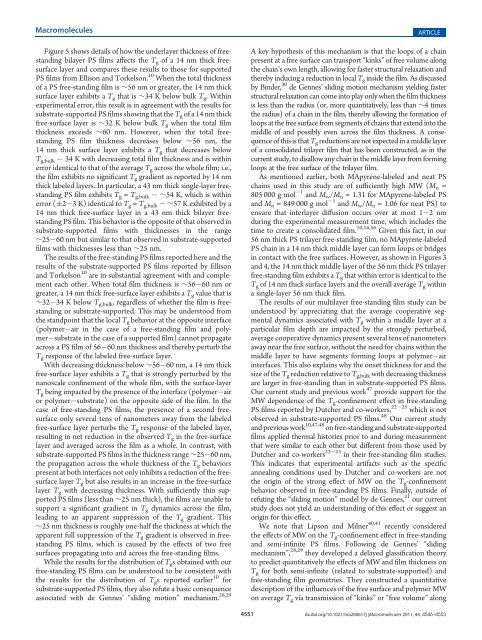
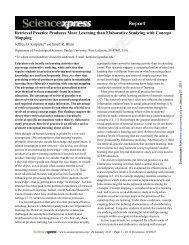
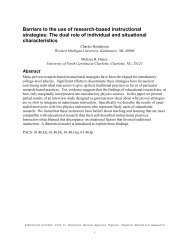


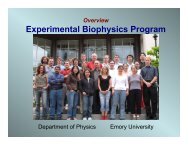


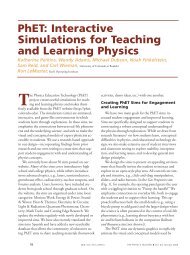
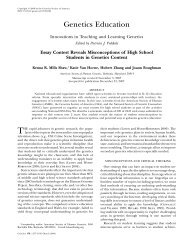
![view the Dish Show [PDF] - Department of Physics - Emory University](https://img.yumpu.com/45032745/1/190x146/view-the-dish-show-pdf-department-of-physics-emory-university.jpg?quality=85)

